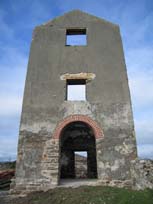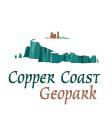Mining Heritage
A brief history
The cliffs west of Bunmahon were mined for lead, silver and copper in the 18th
Century. However the main phase of activity was the mid 19th century when
the
mines east of Bunmahon were worked by the Mining Company of Ireland.
Their
operation fell into two phases.
1825-1850: Knockmahon
The Mining Company of Ireland was established in Dublin in 1824 and quickly
took leases on mineral areas all over the country. Knockmahon proved to be
the
most profitable of all their operations though it took ten years of
development
before they began to be profitable By 1840 it was described
as “the most
important --- mining district in the empire”.
This proved to be the peak, however, and by the mid 1840s they were working
at depths of almost a quarter of a mile and the same distance under the sea
bed at increasing expense. In their search for other lodes in the neighbourhood
they discovered Tankardstown just as Knockmahon was threatening to flood.
1850-1880: Tankardstown
In 1850 the company began to move their entire operation east to
Tankardstown,
including engines and engine houses. Over the next 15 years
the price of copper
fluctuated and the company varied their production and
sales
accordingly. A
peak was reached in 1865 followed by a fairly consistent
decline.
Hopes for an upturn in prices and a new discovery in the Bunmahon area faded
through the 1870s and the last few tons were sold from Tankardstown in 1879.
The engines were sold for scrap and all that remains of the mining operation
that once employed 1200 people are the gaunt ruins of the engine houses on
the cliffs at Tankardstown.
Entire extended families moved away, mainly to America where some of them
wound up working at the Copper Mountain in Butte, Montana. Most had nobody
left home to write so all contact with them was lost. A few did come back to
participate in an attempt revival in 1906, but that was short lived and they left
again.
Sites to visit
While visiting the Copper Coast, you can see some of the witnesses of this
activity at different locations:
Stage cove / Knockmahon (Bunmahon)
There you can see the remnants of the :
- walls of the copper storage yard, with blocks of white quartz containing
green copper,
- adits (horizontal tunnels) in the cliffs, alignment giving clue to the shape
of the ore vein,
- shafts (vertical tunnels) on the headland,
- copper stains on the slipway,
- facilities for shipping the ore out to Swansea, Wales,
- cobbled floor that may have formed part of the quay side,
- mineral tramway route, connecting Tankardstown to the primary ore
dressing floors at Bunmahon .
Tankardstown Engine Houses
(1km east of Bunmahon)
Tankardstown Cornish Engine Houses are some of the main characteristic
buildings linked to the copper mining industry. They were built around 1860
to pump water out of the copper mines and to wind ore up from the depths.
The developments undertaken with InterReg IIIB funding related to these ruins
include:
Excavation works
Excavation works were led during summer 2004 by the Department of
Archeology
- University College Cork, under the overall supervision of
Dr. Colin Rynne.
Conservation works
Conservation works on the different buildings are ongoing.
The tender was
awarded to Cornerstone Ltd.
The buildings before the conservation works:
The buildings during the conservation works:
 |
|
 |
|
The conservation works completed (october 2005):

Landscaping
Once the conservation works were finished, landscaping was done on site.
See photos below for progress.
Landscaping works (July 2006): |

|
| Landscaping works (September 2006):6): |

|
| Landscaping works (November 2006, detail of the amphitheatre):6 |
|
| Landscaping works (December 2006): |
|
|
|
Interpretation
A mining trail was build on site with interpretation boards explaining the use of
the different buildings (with reconstruction drawings) during the mining activity in
the 19th Century and the use of copper in our everyday life.
|
Some of the interpretation panels (installed in April 2007): |
|
|
|
|
|
|
|
|
Europamines
Europamines is the European Mining Heritage Network.
It exists to advance
knowledge, awareness
and
appreciation of the contributions that mining
industries
have made to the development of all
European nations
and
cultures.
The Copper Coast Geopark became
a member of Europamines in 2005. For
further information
about the network, please visit Europamines website. |
|
Genealogy
Little is known about the miners who worked here in the 19th Century. Most of
them left the area with their entire families to work in the copper mines of
Michigan and Montana, USA. With nobody left at home to write to, contacts
were lost.
Please see the genealogy pages of this website as we are trying to
trace the descendants of the Bunmahon miners.
|





